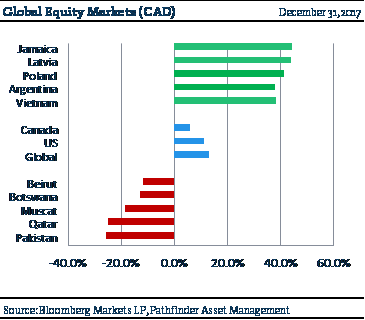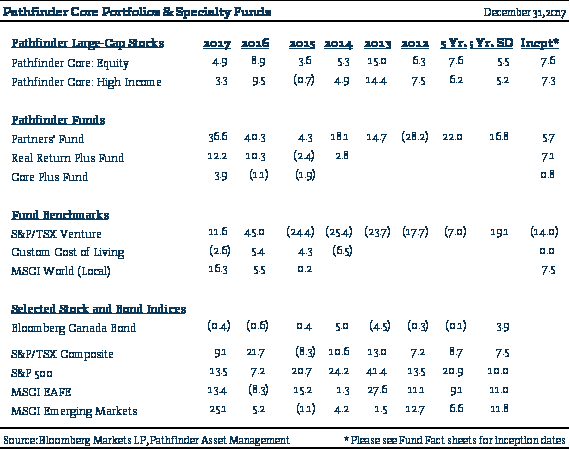EQUALLY INVESTED ... WHAT THIS MEANS:
We believe we created a better platform for money management. Our inception as a family office led to the creation of our Equally Invested™ culture: This means that everyone at Pathfinder invests in the same portfolios and funds and pays the same fee as all of our clients. Also, we (employees), along with our families are the largest investors at Pathfinder so your portfolios are invested right alongside ours.
January 2018
At Pathfinder, we draw a clear distinction between our Core Portfolio (segregated stocks, bonds and cash) and our Pathfinder Funds (our private specialty pooled funds). The investment profiles of these two “baskets” are quite different. The Core Equity Portfolio is managed to produce broad, equity-like market returns but with less risk. The Pathfinder Funds have specialty mandates and are very different vs. a traditional long-only blue-chip portfolio. Our investment thesis is that the combination of these two baskets should produce results that are better than broad equity markets for any given risk level when combined in various mixes, based on client objectives.

If one were to consider the idea of “stock returns” for a moment, one could come up with some materially different data points. This year, there were some very strange results in equity markets which demonstrate how government actions can dramatically distort investment portfolios. For example, the Venezuela Stock market returned 3,610% in local currency (just a little under Bitcoin!!) this year while the Argentinian, Ukrainian, Mongolian and Kazakhstan markets all returned over 70% in local currency. Those markets have significant political influence and would be considered strange outliers. We have presented the best and worst performing markets (excluding the outliers) in the chart above (in Canadian currency). This list is very different from those that made the list last year. While most equity markets did well this year – of the 96 that we track only 10 were below zero – Asian and European based Emerging Markets countries were the best performing group. This is a significant difference from last year where commodity-tilted markets outperformed after significant underperformance in 2015.
As you can see, depending on how you look at the data, there are a variety of ways to judge what broad equity returns look like over a very short-term (1-2 years). What is interesting is that if you look at the same return statistics over multiple years, the best returning countries contain none of the same names. For this reason, we focus on very long-run returns of developed global stocks as our goal for portfolio performance. The MSCI World Equity index in US dollars over the last 40 years has returned about 9%. It is also similar in other major currencies. Thus, increasing our time horizon and attempting to beat that return with less risk seems like a good goal for investors.
Our Investment Thesis:
The Core Equity Portfolio is the blue-chip part of your portfolio. It should generate long-run equity returns. We select stocks from a list of high-quality, stable cash-flowing companies and allocate to cash when we feel there is too much risk in financial markets or when stock prices are too high (the two are not the same). We also use a 9% long-run cost of capital (note it is the same as above) as one of the more significant valuation tests when we consider adding a company as an investment into our portfolios. If we are doing our job correctly we should generate equity like returns with less market risk. We then use the “budgeted risk” in this part of the portfolio to allocate to the Pathfinder Funds.
The Pathfinder Funds are more aggressive by comparison and are managed for performance (either absolute or relative). Furthermore, each of the risk profiles and investment processes are quite different. This is by design so that we do not introduce a high correlation between each fund. As a generalization, the funds are able to use derivatives, leverage, shorting, physical commodities, privates and higher position concentration. Each fund has its own mandate and a short one line description is outlined on the next page. Over the coming weeks, you will receive portfolio manager reviews that will dive into more detail about each fund.
The diversity of risk profiles among each of the mandates at Pathfinder allows our Portfolio Managers and Investment Counsellors to custom blend a portfolio for each client, depending on their needs and investment goals. Less risk taken in the Core Portfolio allows for the budgeted risk to be spent elsewhere. Much of this is accomplished by diversifying asset classes, management strategy and differentiation.
With respect to risk, most people think of risk in terms of losing money. Other more institutionalized investors think of risk in more relative terms – i.e. their portfolio’s return against a benchmark. In the latter case, the absolute return is less important than the relative return. If you have read much of what Pathfinder has written over the years, you would know that we are not big believers in benchmarking. We are more concerned about buying the best companies that we can find and taking a real investment position, rather than hugging widely published index weights (investors can do this cheaply on their own by using Exchange Traded Funds). Thus, risk minimization for us comes from our process and our process allows us to customize this for each client.
As I wrote earlier, please expect more emails from us over the coming weeks. Each portfolio manager will provide an in-depth review of the past year as well as present their current investment outlook. After that, our regular weekly Pathfinder Investment Outlook distribution will continue.

CORE: EQUITY
This is the blue-chip part of your portfolio. It should generate long-run equity returns with less volatility.
CORE: HIGH INCOME
This is the same blue-chip portfolio above but tilted to higher dividend paying stocks.
PARTNERS FUND
This fund invests in high-torque, early-stage companies that have the potential to generate superior returns.
REAL RETURN PLUS FUND
This fund was created to protect and grow purchasing power.
CORE PLUS FUND
This fund exploits global themes and hedging with an objective to generate superior risk-managed returns.
National Instrument 31-103 requires registered firms to disclose information that a reasonable investor would expect to know, including any material conflicts with the firm or its representatives. Doug Johnson and/or Pathfinder Asset Management Limited are an insider of companies periodically mentioned in this report. Please visit www.paml.ca for full disclosures.
*All returns are time weighted and net of investment management fees. Returns from the Pathfinder Partners’ Fund and Partners’ Real Return Plus Fund are presented based on the masters series of each fund. The Pathfinder Core: Equity Portfolio and The Pathfinder Core: High Income Portfolio are live accounts. These are actual accounts owned by the Pathfinder Chairman (Equity) and client (High Income) which contain no legacy positions, cash flows or other Pathfinder investment mandates or products. Monthly inception dates for each fund and portfolio are as follows: Pathfinder Core: Equity Portfolio (January 2011), Pathfinder Core: High Income Portfolio (October 2012) Partners’ Fund (April 2011), Partners’ Real Return Plus Fund (April, 2013), and Partners’ Core Plus Fund (November 2014).
Pathfinder Asset Management Limited (PAML) and its affiliates may collectively beneficially own in excess of 10% of one or more classes of the issued and outstanding equity securities mentioned in this newsletter. This publication is intended only to convey information. It is not to be construed as an investment guide or as an offer or solicitation of an offer to buy or sell any of the securities mentioned in it. The author has taken all usual and reasonable precautions to determine that the information contained in this publication has been obtained from sources believed to be reliable and that the procedures used to summarize and analyze such information are based on approved practices and principles in the investment industry. However, the market forces underlying investment value are subject to sudden and dramatic changes and data availability varies from one moment to the next. Consequently, neither the author nor PAML can make any warranty as to the accuracy or completeness of information, analysis or views contained in this publication or their usefulness or suitability in any particular circumstance. You should not undertake any investment or portfolio assessment or other transaction on the basis of this publication, but should first consult your portfolio manager, who can assess all relevant particulars of any proposed investment or transaction. PAML and the author accept no liability of any kind whatsoever or any damages or losses incurred by you as a result of reliance upon or use of this publication.